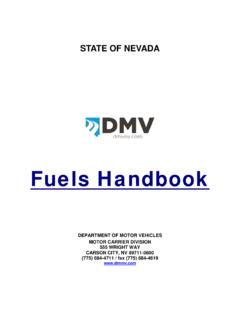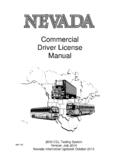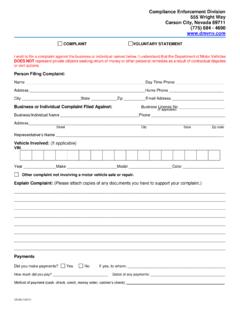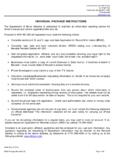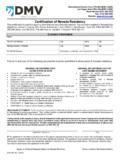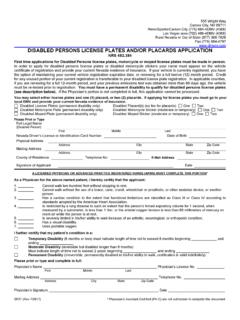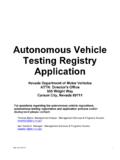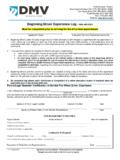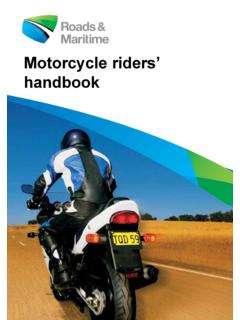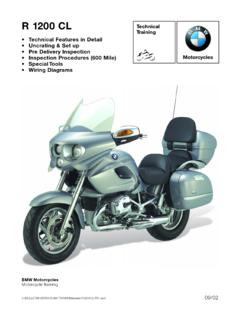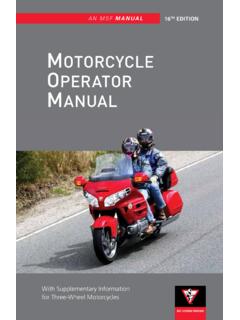Transcription of MOTORCYCLE OPERATOR MANUAL - dmvnv.com
1 MOTORCYCLE OPERATOR MANUAL STATE OF NEVADA DEPARTMENT OF MOTOR VEHICLES March 2018 DMV-701 This MANUAL gives you information on the special knowledge and skills you need to safely operate your MOTORCYCLE on Nevada highways. Nevada administers both knowledge and skills tests before issuing a motorcy-cle driver s license. Those tests are based upon this MANUAL . NEVADA MOTORCYCLE OPERATOR MANUAL DEPARTMENT OF MOTOR VEHICLES 555 WRIGHT WAY CARSON CITY, NEVADA 89711-0900 Brian Sandoval Governor Terri L. Albertson Director A MOTORCYCLE is defined as a motor vehicle equipped with a seat or saddle designed to travel with no more than three wheels in contact with the ground. A trimobile is defined as every motor vehicle designed to travel with three wheels in contact with the ground, at least one of which is power-driven. This does not include a MOTORCYCLE with a sidecar. A moped is defined as a motor-driven scooter or cycle propelled by a small engine which produces no more than 2 gross brake horsepower and has a displacement of no more than 50 cubic centimeters or no more than 1500 watts of final output.
2 It also cannot be designed to travel with more than three wheels in contact with the ground and cannot reach a maximum speed of more than 30 miles per hour. Moped owners must register their mopeds with the DMV. Moped registration is a one-time fee to help prevent against theft. You need a Nevada Class M driver s license if you live in Nevada and want to operate a MOTORCYCLE on Nevada streets and highways. To get your MOTORCYCLE license or instruction permit, you need to complete a DMV-002 Application for Driving Privileges or ID Card or CDL-002 Application for Commercial Driving Privileges at any DMV office. You may also need to present documents as described in "Documents You Will Need" section of the Class C Nevada Driver's Handbook. NOTE: A Class M license is not required when operating a vehicle that meets the definition of a trimobile. You may operate a trimobile while holding any class of license without any endorsements or restrictions.
3 You need to know and understand your MOTORCYCLE s controls and equipment such as choke, gearshift, brakes, starter, throttle, ignition and clutch. Riding a MOTORCYCLE is an enjoyable and challenging pastime. The safest thing you can do for your family and your own safety is to take a MOTORCYCLE safety course and get a Class M driver s license. The More You Know, the Better It Gets. Classes are available for both new and experienced riders. Successful completion of a Basic Rider Course will waive any further testing at the Department of Motor Vehicles. Visit or call the Nevada Rider MOTORCYCLE Safety Program at (800) 889-8779 to find a MOTORCYCLE safety course in your area. INTRODUCTION i You may take your MOTORCYCLE road test on any MOTORCYCLE you do not need to use your own. The test will include normal starts and stops, quick turns, and other maneuvers. You are required to wear a helmet when riding your MOTORCYCLE .
4 If your MOTORCYCLE does not have a windshield or screen, you need to wear a protective face shield or goggles. NOTE: If you have a valid MOTORCYCLE license or endorsement from a state that uses a MOST course and equipment, the skills test may be waived. If you already have another class of driver s license in Nevada, your MOTORCYCLE license will be shown as an endorsement. MOTORCYCLE Instruction Permit Requirements If you have failed the DMV-administered MOTORCYCLE skills test two (2) or more times, you will be permanently denied future MOTORCYCLE instruction permit privileges. When you use your instruction permit, you must: Be in direct visual supervision of a licensed driver who: Has a valid MOTORCYCLE license Is at least 21 years old Has held a MOTORCYCLE license for at least one year Ride in daylight hours only NOT carry passengers NOT drive on freeways or other high-speed roads 18 years of age & older Permits are valid for 6 months from the date of issuance and can only be renewed once in a 5 year period.
5 To complete your permit, you must: Successfully pass the DMV-administered skills test; or Present a certificate (dated within one year) showing successful completion of a course in MOTORCYCLE safety. NOTE: You do not need an instruction permit to take the DMV-administered skills test. Under 18 years of age Permits issued to individuals under 18 years of age are valid for one year from the date of issuance. You may renew your permit as many times as needed but it will expire on your 18th birthday. To complete your permit, you must: Present a certificate (dated within one year) showing successful completion of a course in MOTORCYCLE safety; and Submit a DLD-130 (Beginner Experience Drive Log) with 50 hours logged NOTE: If no course is offered within a 30-mile radius of your residence, you may complete the DLD-130 with an additional 50 hours experience and must take and pass the DMV administered MOTORCYCLE skills test.
6 If you are under 18, you must have a parent or guardian with you at the INTRODUCTION ii DMV to sign the financial responsibility statement on the application. MOTORCYCLE Traffic Laws Motorcyclists have the same rights and responsibilities as other drivers in Nevada. There are also some special conditions. Motorcyclists must wear helmets in Nevada. Protective face shields or goggles are also required unless the MOTORCYCLE is equipped with a windshield or screen. Motorcyclists have the right to use a complete traffic lane. Motorcyclists may not pass or ride next to another vehicle in the same travel lane. motorcycles may not be driven between vehicles in adjacent lanes even if the vehicles are stopped. There is an exception to this law for police officers (NRS ). After complying with the requirements to stop at a traffic signal and prior to the crosswalk, a motorcyclist may proceed straight through or turn left or right if: Two cycles of the applicable traffic lights have been completed due to light malfunction or the light not being triggered by the presence of a MOTORCYCLE No other device prohibits such turns The motorcyclist yields the right-of-way to pedestrians and other traffic proceeding as directed by the traffic signals at the intersection Moped Traffic Laws Moped operators must abide by the same traffic laws as motorcycles .
7 Additionally, moped operators have more responsibilities based on the limitations of their vehicle. Moped operators must remain in the extreme right-hand lane of any road unless: There is a single lane of traffic Preparing to make a left turn (turn must be made within one-quarter mile from entering lane) When driving in the extreme right-hand lane would not be safe; or Directed by a police officer Moped operators and passengers are not required to wear helmets in the State of Nevada; however, helmet use is strongly recommended to avoid serious injuries in case of an accident or crash. Pairing Up Per Nevada Revised Statutes (3), motorcycles and mopeds may, with the consent of the drivers, be operated no more than two abreast in a single traffic lane. Without the consent of the other driver, motorcycles cannot ride side by side and must remain in a staggered formation. Although state INTRODUCTION iii law allows riders to ride two abreast, the preferred formation is staggered.
8 MOTORCYCLE Equipment In Nevada, motorcycles are required to be equipped with the following: Headlights at least one and no more than two Taillight must be a red taillight that can be seen for 500 feet Stoplight or brake light visible for 300 feet in daylight Reflector at least one rear reflector visible for 300 feet when lit with low beams Brakes front and rear Electric turn signals front and rear signals required for all motorcycles manufactured after January 1, 1973 Rearview mirrors one rearview mirror on each handlebar Fenders on front and back wheels Footrests adjustable to fit passengers Horn Muffler INTRODUCTION iv 2 PREFACEW elcome to the Seventeenth Edition of the MSF MOTORCYCLE OPERATOR MANUAL (MOM). Operating a MOTORCYCLE safely in traffic requires special skills and knowledge. The MOTORCYCLE Safety Foundation (MSF) has made this MANUAL available to help novice motorcyclists reduce their risk of having a crash.
9 The MANUAL conveys essential safe riding information and has been designed for use in licensing programs. While designed for the novice, all motorcyclists can benefit from the information this MANUAL original MOTORCYCLE OPERATOR MANUAL was developed by the National Public Services Research Institute (NPSRI) under contract to the National Highway Traffic Safety Administration (NHTSA) and within the terms of a cooperative agreement between NHTSA and the MSF. The MANUAL and related tests were used in a multi-year study of improved MOTORCYCLE OPERATOR licensing procedures, conducted by the California Department of Motor Vehicles under contract to purpose of this MANUAL is to educate riders and to help them avoid crashes while safely operating either a standard two-wheel MOTORCYCLE or a three-wheel MOTORCYCLE . This latest edition has undergone significant improvements, and contains new, more in-depth information, designed to: Guide riders in preparing to ride safely Develop effective street strategies Give riders more comprehensive understanding of safe group riding practices Describe in detail best practices for carrying passengers and cargoIn promoting improved licensing programs, the MSF works closely with state licensing agencies.
10 The Foundation has helped more than half the states in the nation adopt the MOTORCYCLE OPERATOR MANUAL for use in their licensing licensing, along with high quality MOTORCYCLE rider education and increased public awareness, has the potential to reduce crashes. Staff at the Foundation are available to assist governmental and private agencies in efforts to improve MOTORCYCLE Buche President, MOTORCYCLE Safety Foundation 3 CONTENTS THE RIDER AND THE MOTORCYCLE 4 PREPARING TO RIDEWear the Right Gear 5 Know Your MOTORCYCLE 7 Know Your Responsibilities 10 RIDE WITHIN YOUR ABILITIESB asic Vehicle Control 11 Keeping Your Distance 15 SEE 20 Intersections 21 Increasing Conspicuity 24 Crash Avoidance 27 Handling Dangerous Surfaces 30 Mechanical Problems 33 Animals 34 Flying Objects 35 Getting Off the Road 35 Carrying Passengers and

